The synthetic psychoactive drug, Captagon, has been linked to substance abuse in the Middle East and found to have a unique chemical complexity that makes it particularly potent.
Referred to as the “drug of the jihad”, Captagon was present during the Civil War conflict in Syria and is still evidently used by Islamic State fighters as a stimulant to improve performance. Ii is believed that capagon production could be one of the main sources of income for jihadist terrorists in the region.
Here is what you need to know:
What is Captagon?
Captagon has been around for a long time. First synthesized in 1961, Captagon was considered a legal and safer alternative to amphetamines and was used as a treatment for narcolepsy and hyperactivity including ADHD disorders.
It was distributed under the brand name Captagon and it falls under the category of amphetamines and the chemical compounds of theophylline and fenethylline. It became illegal in most countries, including the United States in the 1980s, when its addictive qualities became apparent.
The effects of Captagon.
Captagon is a supercharged caffeine-like substance that after ingestion is metabolized and broken down into the stimulant amphetamine and fenethylline. While it is not exactly clear how the drug works in the body, the chemical reaction is similar to the natural hormones released in the body like adrenaline and dopamine. They charge the reward and pleasure neurotransmitters and cause a surge in energy while boosting physical performance. Similar amphetamines are touted as increasing alertness as well as reducing fear and inhibitions which make them ideal for the madness of the Syrian battleground.
The psychological effects of Captagon in terrorist groups is hard to ascertain. Autopsy reports on perpetrators in Europe, have identified the presence of amphetamines in toxicological findings, but are yet to determine what specific stimulant is used and if it can increase aggression, violence and psychotic incidents.
Isis Production and use of Captagon in the Syria Conflict.
Illicit production of large quantities in recent years has been concentrated in the Arabic Peninsula and Middle East region. Primary centres of production have been identified in Syria and Lebanon and exported or circulated domestically. Most counterfeit or fake Captagon pills analyzed, do not contain fenethylline but amphetamine, caffeine and other related substances. In 2019, a record number of 33 million pills were seized in Greece, from the Syrian city of Latakia, destined for the Chinese market. More recently, Italian police confiscated 84 million pills, worth an estimated €1bn, presumably for the European market that has seen a decline in production due to the global pandemic. Italian police said the pills were made to fund the Islamic Republic (a.k.a ISIS) jihadist group which still controls regions of Syria.
Who buys Captagon?
The effect of the Captagon epidemic in the Middle East is two-fold, and evidently appeals to a wide range of people; students use it as a stimulant during exam season and amphetamines also have a history of being used for weight loss. While the latest shipment seizures in Europe could be a result of the pandemic – the theory being that as the lockdown affected local drug production within Europe, crime syndicates imported more drugs from abroad – the largest market is in the east, in Saudi Arabia, Qatar and the United Arab Emirates where it is popular among the affluent middle classes.
In a region that is still plagued by the devastating effects of war and civil unrest it is likely that both the production and local consumption of Captagon is likely to continue and with it, the amplification of the destructive effects it is having in the region.














